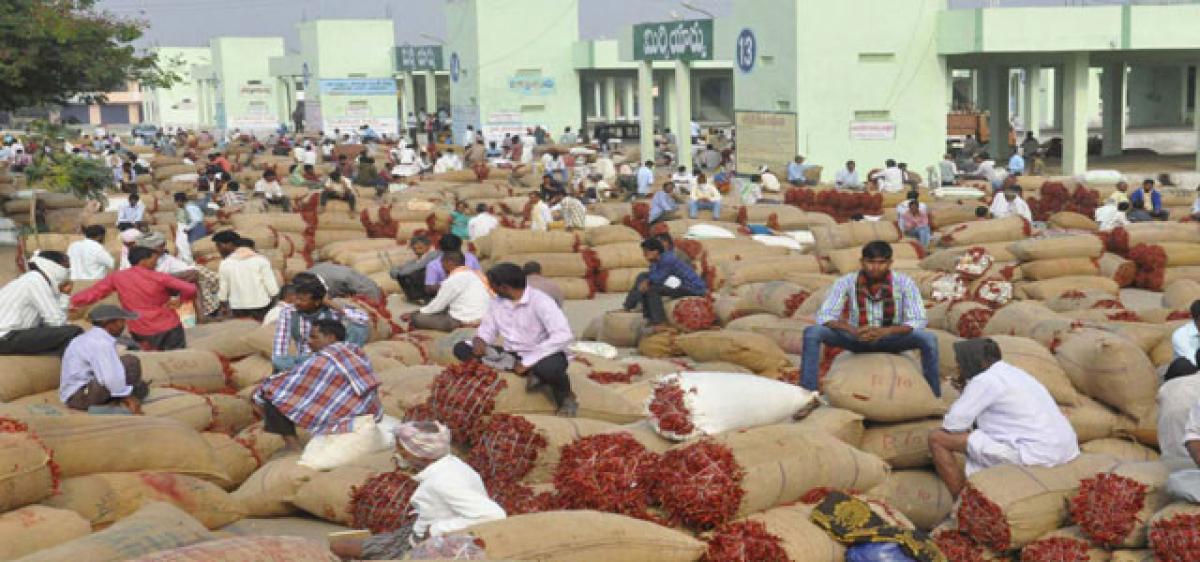Live
- AP Gov’t Partners with FSSAI to Enhance Food Safety Standards with Rs. 88 Crore MoU
- Delhi HC issues directions on expeditious release of compensation to POCSO victims
- 1st Test: Crawley, Root lead fight back as England trail by 460 runs against Pakistan
- 74 smart city projects completed in Bihar, claims minister
- My Characters Always Leave a Mark: Shiva
- Navratri 2024 Day 7: Worship of Maa Kalaratri – Rituals, Colour, Muhurat, and Significance
- UN officials urge negotiations to restore stability along Lebanon-Israel border
- Now, INDIA bloc will rant EVM saga: Jitan Ram Manjhi on Haryana poll outcome
- Durga Puja 2024: Dates, Muhurat, History, Rituals, and Celebration Highlights
- Delhi HC asks District Courts to properly record appearances of advocates in order sheets
Just In

Red chilli farmers’ fortunes swayed as the support price for the crop swung from the maximum Rs 12,500 in January to the current Rs 3000 to Rs 4000 a quintal.
Warangal, Khammam & Guntur: Red chilli farmers’ fortunes swayed as the support price for the crop swung from the maximum Rs 12,500 in January to the current Rs 3000 to Rs 4000 a quintal.
Woes of the farmers were compounded with the negligence of Marketing Department and duping at the hands of middlemen. As a result, the chilli farmer is getting caught in a virtual debt trap.
The losses are forcing the farmers to hit bottle, the alcoholism is leading to quarrels in families and even some others are contemplating suicide. The Hans India team toured Asaalapalli in Sangem mandal of Warangal rural district.
A farmer of the village Nyala Mallaiah, a veteran for over 30 years, raised the crop in five acres, including one-acre leased land, borrowing Rs 4 lakh from others. He incurred Rs 1.20 lakh towards input costs for each acre. He was disheartened to learn that the support price for the crop did not cross Rs 3000 a quintal.
He disposed half of the crop to pay wages to agriculture workers. He left the rest of the crop in the farm untended. For want of water, the crop withered away. He incurred a loss of at least Rs 70,000 to Rs 80,000 an acre.
Over 50,000 farmers raised the crop borrowing money from usurers, purchasing seeds in the black market, paid an inflated wages of Rs 200 to Rs 300 per head to farm workers for harvesting the crop. The input costs increased, but the support price nosedived to the half. At many places, the farmers were seen setting fire
to their crops for want of remunerative price for their produce.
According to farmer Adinarayana from Tanikella village of Konijerla mandal of Khammam district, the agriculture market yard at Khammam was flooded with red chilli bags daily as the area under the crop was increased manifold.
Farmers not only from Telangana but also those from the neighbouring Andhra Pradesh were bringing the crop to the market yard here since it is the biggest market yard after the Warangal market.
The average area of cultivation of red chilli in the district increased to 28,000 hectares this year as against 21,000 hectares last year.
The poor farmer, Adinarayana, took two and half acres on lease and sowed red chilli and hoped to clear his last year’s Rs 8 lakh debts as the yield was very good. But upon harvesting, he realised that he would not be able to pay wages to the agriculture workers let alone clearing his debts. Unable to bear with the mounting pressure, he is contemplating suicidal intentions.
His wife Mallamma said that she and her husband were shell-shocked at the nose-diving prices and were in a dilemma whether to harvest the crop and allow it to wither away. The condition of other farmers Nagaraju and Sarakka is no different. Unless the government comes to the chilli farmers’ rescue, there will be no sheen in their lives.
In Guntur district, Muttaiah of Nandigam village in Sattenapali mandal raised red chilli in five acres investing Rs 5 lakh at the rate of Rs 1 lakh an acre, but realised only Rs 1 lakh selling the crop harvested in five acres. Meanwhile, his hut caught fire, compounding the problems further. The 40-year-old farmer is raising the red chilli crop for the past 20 years. He is a father of three girls. He incurs an expenditure of Rs 2 lakh per annum towards the cost of education of his daughters and running the family.
The farmers are of the view that they can get over their problems provided the Minimum Support Price of red chilli is pegged at Rs 8000 a quintal as the crop yield came down to 20 to 25 quintals an acre. Some of the farmers are storing the crop in cold storages in anticipation of support price escalation in future.
In case of some others, they are greeted by no space boards at the cold storages. It is high-time that the State government intervene to help the red chilli farmers deploying the Markfed.

© 2024 Hyderabad Media House Limited/The Hans India. All rights reserved. Powered by hocalwire.com







